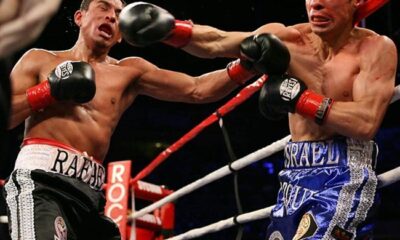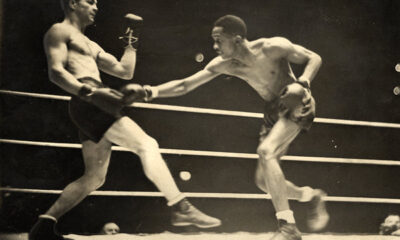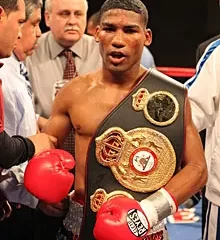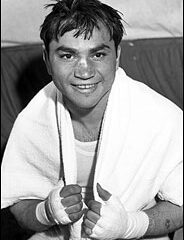Featured Articles
This Day in Boxing History: Three Fights That Trace Boxing’s Evolution Across Eras
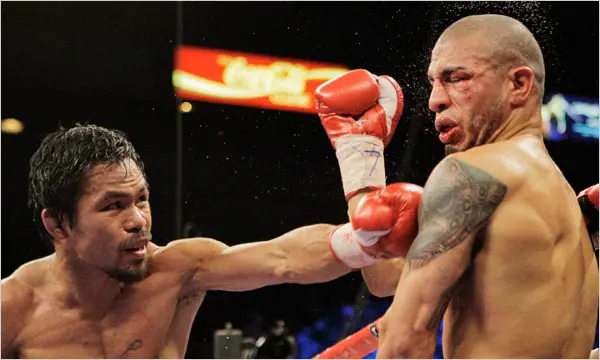
This Day in Boxing History: Three Fights That Trace Boxing’s Evolution Across Eras
Across different eras of the sport — from wartime America to Ali’s golden prime to the globalized fight scene of the 2000s — this day has produced performances that reveal the sport’s evolution. November 14 has hosted champions at their sharpest, divisions at transition points and fights that, while sometimes overlooked, tell us a great deal about boxing’s shifting landscape. What follows is a journey through three of the most significant moments that occurred on this deceptively important date.
1944: Manuel Ortiz and the Wartime Champions
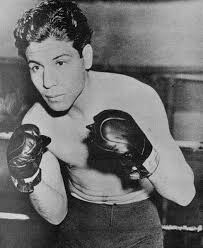
The year was 1944, and much of the world was consumed by uncertainty. Men were fighting overseas, rations dictated daily life, and sports — though still alive — carried the weight of distraction and morale more than glamour. To be a champion during wartime meant something different. Headlines were smaller, crowds thinner, celebrations subdued.
On November 14, 1944, bantamweight champion Manuel Ortiz stepped into a Los Angeles ring to defend his title against Luis Castillo. Ortiz was the kind of champion whose brilliance was made more impressive by its consistency. He didn’t draw the massive audiences of the heavyweights, and he didn’t campaign for acclaim. What he did instead was win — again and again, with technical precision, conditioning, and a clean, disruptive jab that frustrated challengers long before it beat them.
Against Castillo, Ortiz showcased the methodical dominance that defined his prime. Over nine rounds, he controlled the space, dictated the tempo, and broke Castillo down until the referee stepped in. It wasn’t a fight that grabbed national headlines, but it was significant: a confident, capable champion defending his belt during one of the most unstable periods of the century.
In many ways, Ortiz’s November 14 victory represents a part of boxing history that is easy to overlook. Before television, before global pay-per-view, before highlight reels circulated on social media, champions like Ortiz built their legacies brick by brick, defense by defense. November 14, 1944 is a reminder that the sport’s foundations were laid by fighters who carried the mantle quietly — and carried it well.
1966: Ali’s Night of Perfection

If Ortiz represents the foundational past of boxing, then Muhammad Ali on November 14, 1966 represents the sport entering full technicolor — charisma, cultural resonance, and athletic brilliance colliding under the bright lights of the Houston Astrodome.
Ali already held the heavyweight title at the time, but not all title defenses are created equal. Some are routine. Some are business. And some become landmarks in a fighter’s artistic arc. The fight against Cleveland “Big Cat” Williams falls into the third category.
Williams, once one of the division’s heaviest hitters, had survived a gunshot wound two years earlier that left him with devastating internal injuries. His comeback was courageous, but the fight ended in the third round, with Williams in diminished form and Ali in all-time great shape.
Ali showcased a level of speed, fluidity and dominance that would become part of his lasting myth. He glided, he circled, he fired combinations with surgical precision. It was a masterclass that encapsulated Ali at the height of his powers, both physically and stylistically. Many still point to this performance as the clearest snapshot of Ali’s brilliance before his forced exile from the sport.
2009: Pacquiao and the Digital Age
Decades later, boxing looked different again. The sport’s reach was being amplified in new ways: streaming and pay-per-view linking audiences across time zones, fighters from every continent, brands embedded into promotions. By November 14, 2009, Manny Pacquiao was an international phenomenon.
Decades later, boxing looked different again. By November 14, 2009, the sport’s reach was being amplified in new ways: fighters were still global, but so was how fans consumed them. The rise of broadband and online video meant more people around the world could follow big fights in near–real time, not just through traditional TV broadcasts. At the same time, frameworks like “TV Everywhere” were emerging, allowing cable-TV subscribers to stream live and on-demand content online — a bridge that helped boxing tap into its international audience more deeply. For a fighter like Manny Pacquiao, that meant his bouts weren’t just big in the U.S. or the Philippines — they were increasingly accessible to viewers across continents via digital platforms.
His opponent that night, Miguel Cotto, was a champion cut from traditional cloth: disciplined, powerful, durable, and as proud as any fighter Puerto Rico has ever produced. Their matchup at the MGM Grand in Las Vegas drew enormous attention, pairing Pacquiao’s speed and explosiveness with Cotto’s precision and grit.
From the sound of the opening bell, the fight delivered everything modern boxing fans hoped for. Pacquiao moved with frenetic sharpness, firing from angles that he seemed to create from nowhere. Cotto answered with hard, disciplined counters — but it was Pacquiao’s adaptability that proved decisive. He dropped Cotto twice within the first four rounds and pressed the action relentlessly until the late-fight stoppage.
The victory made history: Pacquiao became the first fighter ever to win world titles in seven different weight divisions, solidifying his place not only among the greatest of his generation but among the most versatile champions in the sport’s long chronology. Cotto, for his part, fought with heart and grit, adding another layer to his own legacy as one of the toughest competitors of his generation.
In contrast to Ortiz’s modest wartime defense and Ali’s televised spectacle, Pacquiao’s November 14 triumph unfolded under the full glare of modern global sports culture. It was a night that showed what boxing had become: international, multimedia, widely commercialized — yet still deeply human, deeply personal, and deeply rooted in the old virtues of bravery and craft.
November 14: A Date, a Timeline, a Story
Taken together, these three fights reveal November 14 as more than a footnote in the boxing almanac. It is a date that consistently reflects the sport’s values and evolution: champions asserting dominance, divisions shifting in identity and fighters pushing the boundaries of what greatness looks like. Ortiz’s bantamweight consistency in the 1940s represents the quiet craftsmen who helped build the sport’s foundation. Ali’s heavyweight artistry in the 1960s embodies the explosive transformation into cultural spectacle. And Pacquiao’s multi-division conquest in the 2000s reflects a sport stepping into the digital era — a time when broadband, online video, and emerging streaming platforms allowed a cross-continental superstar to be watched in real time by fans far beyond traditional broadcast borders. November 14 is a prism that refracts the various eras of the sport.
Fun Facts:
Manuel Ortiz – He was an all-time great from an era when greatness demanded toughness as much as talent. Born in July 1916, he was just 26 when he claimed the world bantamweight title, launching one of the most accomplished reigns the division has ever seen. A supremely durable fighter, Ortiz was stopped only once in 130 bouts — and that was due to cuts. His longevity was remarkable for a lighter-weight boxer of his era, and the record shows it: sixteen of his losses came only after he entered his thirties, an age when most bantamweights historically began to fade. Yet even as the years caught up with him, Ortiz’s skill, grit, and consistency secured his place among the bantamweight legends, a champion built for a time when you had to earn every inch of your legacy.
Cleveland “Big Cat” Williams – His story took a dramatic turn in 1964 when he was shot in the abdomen during a traffic stop, an injury so devastating it cost him a kidney, more than ten feet of intestine, and left a bullet permanently lodged in his hip. Remarkably, he survived four surgeries, lost over 60 pounds, and suffered partial paralysis in his hip — yet still returned to the ring just 15 months later. Before the shooting, Williams was one of the heavyweight division’s most feared punchers, so dangerous that even Sonny Liston considered him a serious threat. His physical decline after the injury was clear, yet his resilience became a defining part of his legacy. He even forgave the patrolman who shot him and shook his hand before fighting Muhammad Ali in 1966 — a moment that stunned many and revealed a quiet depth beneath his intimidating reputation.
Manny Pacquiao vs Miguel Cotto – When they met in 2009, it was one of those rare occasions when two future Hall of Famers collided squarely in their primes. Fights like that are increasingly uncommon, and it’s becoming entirely plausible that one day a fighter will enter the Hall without ever having beaten — or even faced — another Hall of Famer. If that happens, the sport will have to wrestle with a tricky question: what exactly qualifies a fighter for enshrinement?
-

 Featured Articles3 weeks ago
Featured Articles3 weeks agoResults from Australia where Cruiser Champ Jai Opetaia Starched Another Overmatched Foe
-

 Featured Articles3 weeks ago
Featured Articles3 weeks agoMichael Hunter vs Eli Frankham: A Strange Match-Up at a Storied Venue
-
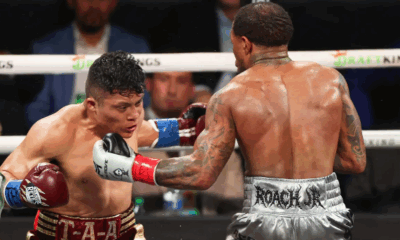
 Featured Articles3 weeks ago
Featured Articles3 weeks agoResults from San Antonio where Cruz vs Roach Ended in a Stalemate
-
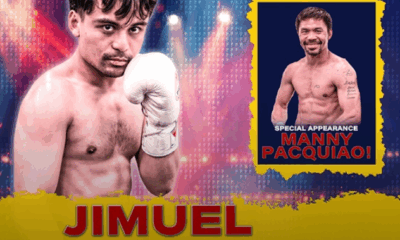
 Featured Articles4 weeks ago
Featured Articles4 weeks agoAvila Perspective, Chap. 353: ‘Pacman’ at Pechanga and More
-
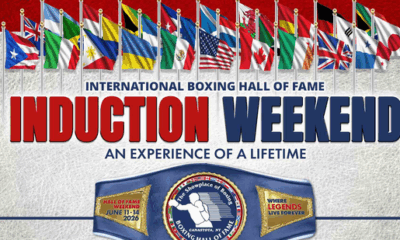
 Featured Articles3 weeks ago
Featured Articles3 weeks agoGennadiy Golovkin, Nigel Benn, and Antonio Tarver named to the Boxing Hall of Fame
-

 Featured Articles4 weeks ago
Featured Articles4 weeks agoLazaro Lorenzana Defeats Luis Arias on Manny Pacquiao’s First U.S. Promotion
-

 Featured Articles2 weeks ago
Featured Articles2 weeks agoDiego Pacheco, Joe Cordina, Tito Mercado, and Skye Nicolson Triumph in Stockton
-

 Featured Articles2 weeks ago
Featured Articles2 weeks agoMurat Gassiev KOs Kubrat Pulev in Dubai

